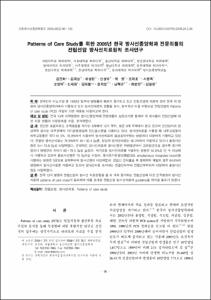KUMEL Repository
1. Journal Papers (연구논문)
1. School of Medicine (의과대학)
Dept. of Radiation Oncology (방사선종양학)
Patterns of Care Study를 위한 2006년 한국 방사선종양학과 전문의들의 전립선암 방사선치료원칙 조사연구
- Affiliated Author(s)
- 김진희
- Alternative Author(s)
- Kim, Jin Hee
- Journal Title
- Radiation Oncology Journal
- ISSN
- 2234-1900
- Issued Date
- 2008
- Abstract
- Purpose: To conduct a nationwide academic hospital patterns of the practice status and principles of radiotherapy for prostate cancer. The survey will help develop the framework of a database of Korean in Patterns of Case Study.
Materials and Methods: A questionnaire about radiation treatment status and principles was sent to radiation oncologists in charge of prostate cancer treatment at thirteen academic hospitals in Korea. The data was analyzed to find treatment principles among the radiation oncologists when treating prostate cancer.
Results: The number of patients with prostate cancer and treated with radiation ranged from 60 to 150 per academic hospital in Seoul City and 10 to 15 outside of Seoul City in 2006. The primary diagnostic methods of
prostate cancer included the ultrasound guided biopsy on 6 to 12 prostate sites (mean=9), followed by magnetic resonance imaging and a whole body bone scan. Internal and external immobilizations were used in
61.5% and 76.9%, respectively, with diverse radiation targets. Whole pelvis radiation therapy (dose ranging from 45.0 to 50.4 Gy) was performed in 76.9%, followed by the irradiation of seminal vesicles (54.0∼73.8 Gy) in 92.3%. The definitive radiotherapy doses were increased as a function of risk group, but the range of radiation doses was wide (60.0 to 78.5 Gy). Intensity modulated radiation therapy using doses greater than 70 Gy, were performed in 53.8% of academic hospitals. In addition, the simultaneous intra-factional boost (SIB) technique was used in three hospitals; however, the target volume and radiation dose were diverse. Radiation therapy to biochemical recurrence after a radical prostatectomy was performed in 84.6%; however, the radiation dose was variable and the radiation field ranged from whole pelvis to prostate bed.
Conclusion: The results of this study suggest that a nationwide Korean Patterns of Care Study is necessary for the recommendation of radiation therapy guidelines of prostate cancer.
Key Words: Prostate cancer, Radiation, Patterns of care study
목적: 한국인의 비뇨기암 중 1990년 말부터 발병률이 빠르게 증가되고 있는 전립선암의 치료에 있어 전국 각 병원의 방사선종양학과에서 시행되고 있는 방사선치료의 현황을 조사, 분석하고 이를 바탕으로 전립선암의 Patterns of care study (PCS) 개발의 기본 자료로 이용하고자 한다.
대상 및 방법: 전국 13개 대학병원의 방사선종양학과 전문의들의 설문조사를 통하여 각 의사들의 전립선암에 대한 치료 현황과 치료원칙을 수집, 분석하였다.
결과: 진단은 초음파유도 조직생검을 적게는 6개에서 12개 부위, 평균 9개 부위에서 얻고 있으며 진단당시의 영상학적 검사는 대부분에서 자기공명영상과 전신골스캔을 사용하고 있다. 방사선치료를 시행할 때 내부고정물과 외부고정물은 각각 61.5%, 76.9%에서 사용하며 방사선치료의 임상표적부위는 병원마다 다양하게 시행하고 있었다. 전골반 방사선치료는 76.9%에서 45∼50.4 Gy를, 정낭의 방사선치료는 92.3%에서 시행하고 있으나 총방사선량은 54∼73.8 Gy로 다양하였다. 근치적인 방사선치료의 방사선량은 저위험군에서 고위험군으로 갈수록 증가하였으나 병원간의 차이가 60∼78.5 Gy로 넓었다. 세기조절 방사선치료를 시행하는 병원은 53.8%로 반 수 이상에서 시행하고 있으며 총방사선량은 70 Gy이상 이었다. 동시추가분할선량법(SIB; simultaneous integrated boost)을 시행하는 병원은 3곳으로 표적부피와 방사선량이 다양하였다. 전립선 전적출술 후 생화학적 재발의 경우 84.6%의병원에서 방사선치료를 시행하고 있으며 방사선치료 조사야는 전골반와부터 전립선부위까지 다양하며 총방사선량도 다양하였다.
결론: 전국 13개 병원의 전립선암의 방사선 치료현황을 볼 때 계속 증가하는 전립선암에 대한 전국병원의 방사선 치료의 patterns of care study가 필요하며 이를 토대로 전립선암 방사선치료의 guideline을 제시할 필요가 있겠다.
핵심용어: 전립선암, 방사선치료, Patterns of care study
- Alternative Title
- A Patterns of Care Study of the Various Radiation Therapies for Prostate Cancer among Korean Radiation Oncologists in 2006
- Department
- Dept. of Radiation Oncology (방사선종양학)
- Publisher
- School of Medicine
- Citation
- 김진희 et al. (2008). Patterns of Care Study를 위한 2006년 한국 방사선종양학과 전문의들의 전립선암 방사선치료원칙 조사연구. Radiation Oncology Journal, 26(2), 96–103. doi: 10.3857/JKSTRO.2008.26.2.96
- Type
- Article
- ISSN
- 2234-1900
- Appears in Collections:
- 1. School of Medicine (의과대학) > Dept. of Radiation Oncology (방사선종양학)
- 파일 목록
-
-
Download
 oak-bbb-1049.pdf
기타 데이터 / 411.51 kB / Adobe PDF
oak-bbb-1049.pdf
기타 데이터 / 411.51 kB / Adobe PDF
-
Items in Repository are protected by copyright, with all rights reserved, unless otherwise indicated.